
The first thing and most important step of learning how to play the accordion is to learn the right position of your hands and how to hold the instrument. It’s very important to know how to hold the accordion while sitting or standing in order to avoid back problems, pinching arm muscles, and the inability to play fast songs. You must find a way to give proper positioning to the instrument, to achieve complete freedom of movement for both hands.
Accordion straps
Usually, accordions have two shoulder straps to support the weight of the accordion and one bass strap to push and pull the bellows. Modern instruments have also a little strap that binds the two shoulder straps behind your back.

Shoulder straps
To give the accordion a comfortable and safe position, it’s of the utmost importance to adjust the straps in a proper way. The straps are adjusted depending on the size of your body. You should feel natural and comfortable.

- The right strap should be longer than the left strap. It will help your right hand to move up and down the keyboard freely.
- A tight left strap will keep steady the accordion while pulling and pushing the bellows.
- The straps must be set so that the keyboard of the accordion is under the chin, in an almost central position with respect to the torso.
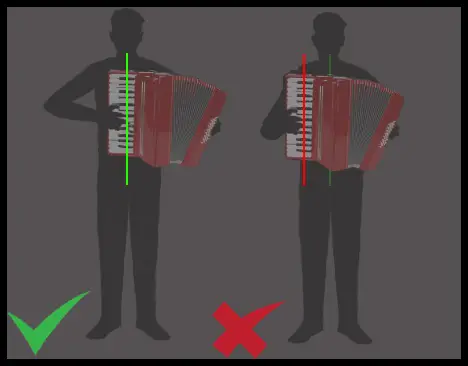
If you run out of holes in your belt, you can add them by yourself. There is nothing wrong with making one more hole, which will make you feel more comfortable while you are playing.
If you feel that some parts of your body start to be in pain then you are doing something wrong.
Cross strap
I use a cross-back strap when I play in a standing position or sitting on a barstool. The main weight of the accordion is on the left side of the instrument. The cross-back strap helps to distribute evenly the weight of the accordion.
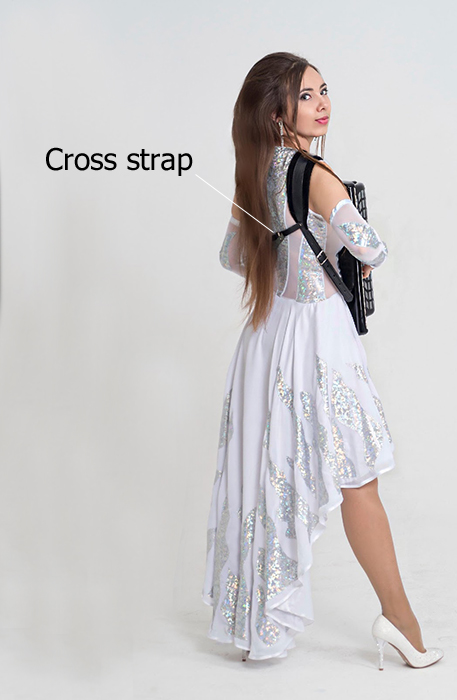
Bass strap
Your left wrist should fit tight between the bass strap and the left side of the accordion:
- if it’s too tight, you won’t be able to move your left hand up and down to reach every button on the bass side
- if it’s too loose, you will feel uncomfortable pulling the bellows because your hand will shift too far from the bass buttons.
The hand should not dangle when you are playing. You can fix the size of your bass strap using the wheel on the left side of your instrument.

Check out this selection of accordion straps on *ThomannMusic.
The correct position of the right-hand
If you want to memorize the correct posture of your right hand’s fingers, put the hand on your knee, fix this position, and transfer it to the keyboard.
- The forearm with the hand should form a horizontal line and the hand should rest in a free and natural position on the keys.
- Your fingers should rest on the keys at a nearly 90-degree angle. If you’re playing with straight fingers, stop it, that’s wrong!
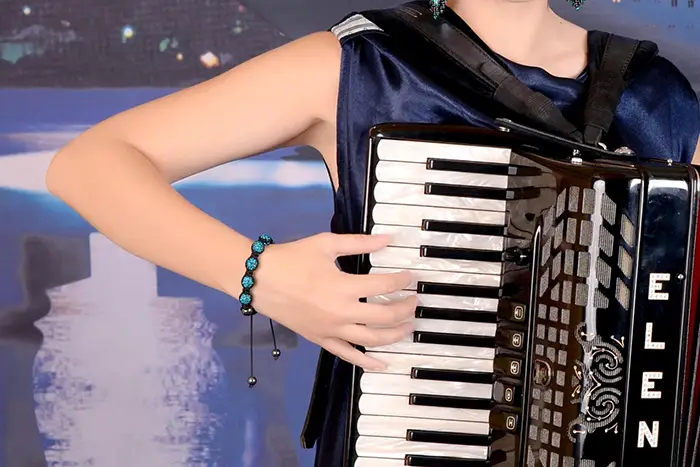
Which is the correct position of the wrist?
The wrists must be absolutely free and loose, not protruding up or down. The hand should be a continuation of the forearm and become one straight line with it.

Which is the correct position of the elbow?
To determine the correct position of the right elbow on the accordion put your hand on your chest, remember this position and transfer it to the keyboard.
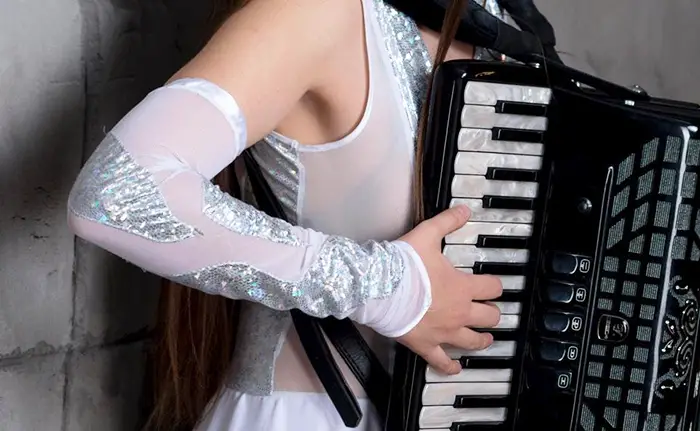
The elbow should be in line with the keyboard when moving up and down but don’t raise it too high otherwise you will strain your shoulder.
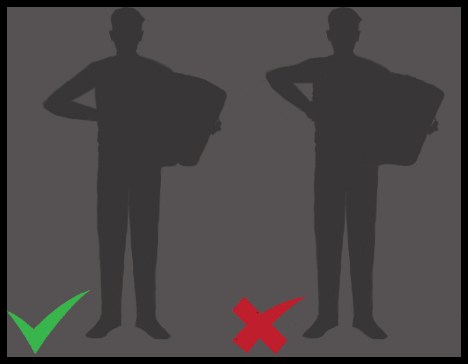
It will be a little uncomfortable at first, but this is completely normal and you will get used to it soon!
I understand if during the first month, you want to put your right elbow down because you will feel uncomfortable but if you keep your elbow in the wrong position you will bend your wrist stressing your hand.
FAQ: Is it possible to play the accordion with long nails?
I’m so sorry but it’s impossible to play the accordion with long nails. Dear girls and women, as a woman, I understand your pain but there’s nothing you can do about it: if you want to play the accordion you have to shorten your nails so you can press the keys with your fingertips.
The correct position of the left-hand
The position of the left hand should be natural, the fingers should be slightly bent so you can push the bass buttons just with your fingertips. Bass buttons are so close together that it will be impossible to play one button at a time if you don’t bend your fingers. Beginners often push more than one button because their fingers are not bent enough.
The thumb is not involved in playing because it helps guide the movement of the bellow, it presses against the grid of the left side of the accordion body.
How to hold the accordion while sitting
Keep your back straight and the soles of your feet flat on the floor. You must rest the accordion weight almost exclusively on the left leg. The lower end of the keyboard must rest against the inside of the right leg so as to give a point of support to the instrument especially when closing the bellows. The bellows that you open and close with the left hand must have a completely free movement without rubbing against your body.

What kind of chair should you use?
A comfortable standard-size chair without armrests should be your best choice. Even a stool could be used for this purpose; the important thing is that whatever kind of chair you choose, it should allow having your feet completely flat on the floor and your knees bent at a 90-degree angle.
If the chair is too tall, you can use a special stand for your legs or you can use some books as a footrest. Remember to always keep your back straight.
Playing sitting on a barstool
Sometimes could happen that you have to play on a stage with other musicians who play in standing position. There is nothing wrong with being the only musician on stage sitting in a chair especially if you play certain genres like classical or jazz but in some other situations, like playing in a rock or in a pop band, performances on stage are way more dynamic.
In these cases, accordionists usually play in standing position but a good compromise (or a way to sit down from time to time during a long concert) could be sitting on a high barstool.
You will need a barstool with a footrest so you can support your accordion with your left leg.

You are not standing or sitting! It’s a mixed position.
I recommend this position only to advanced accordionists: it’s a good option for those people who already play the accordion confidently, and who have their hands, wrists, and elbow in the correct position.
80% of the accordion’s weight falls on the left leg: sit on the barstool bending the left knee at an angle of 90 degrees. Put the right foot on the floor.
In this position, your right leg will be almost straight, for this reason, the keyboard won’t touch the inside of the thigh and when you will close your bellow the accordion will move to the right. That’s why we need to use a cross strap to avoid our instrument slipping to the right while we are pushing the bellows.
Check out this selection of barstools from ThomannMusic.com
How to hold the accordion while standing
Differently from the sitting position where almost all the weight of the accordion rests on your left leg, in the standing position you have to support the weight of the accordion with your shoulders and your body. Try to keep your back straight, the shoulders back and your chest out. The accordion is a heavy instrument and you should be in good shape to play it while standing. Playing the accordion in a standing position could be tiring for your neck, your shoulders, your back, and your feet, for this reason, I recommend smaller accordions for this purpose. Your spine will thank you, believe me! Plus, a smaller accordion allows you to have more freedom of movement.

If you are a girl and you often perform in high heels, you can use a corset or a corset dress and orthopedic insoles. These little things are very useful especially if you playing around 3-4 hours every day.
Size of the accordion
The instrument should not be too big for you. It will be physically difficult for you to play a big accordion if you are small. In particular, I do not recommend buying a big instrument for a child. The muscles of his spine have not strengthened yet and there’s no need to give them extra weight. The suitable models for children are 1/2 or 3/4. You can always buy a bigger accordion when your child will grow up.
Conclusion
I hope this article can help you learn how to hold the accordion during your practice session at home or when you perform on a stage.
Let’s recap:
- You must find a way to give proper positioning to the accordion, to achieve complete freedom of movement for both hands.
- Set the right strap longer than the left strap.
- The straps must be set so that the keyboard of the accordion is under the chin, in an almost central position with respect to the torso.
- Use a cross-back strap to distribute evenly the weight of the accordion.
- Set the bass strap not too tight and not too loose.
- The forearm with the hand should form a horizontal line and the hand should rest in a free and natural position on the keys.
- Your fingers should rest on the keys at a nearly 90-degree angle.
- The wrists must be absolutely free and loose, not protruding up or down.
- The elbow should be in line with the keyboard when moving up and down but not too high.
- The position of the left hand should be natural, the fingers should be slightly bent so you can push the bass buttons just with your fingertips.
- While sitting you must rest the accordion weight almost exclusively on the left leg.
- Playing the accordion in a standing position could be tiring: if you can, use a smaller or lighter accordion.
Keep reading our tutorials!
Author: Elena Stenkina
Photos by: Elena Stenkina
Editor: Giovanni Lucifero
*AccordionChords is affiliated with ThomannMusic.com. If you click on a link to ThomannMusic.com and make a purchase, I may earn a commission. This commission helps keep our website running and allows us to provide valuable content. Thank you for your support!
Thanks this tutorial was really useful
Thank you for your appreciation! 🙂
Just a thank you for this excellent overview. I’m not a beginner, but have never had lessons, so reviewing advice like this periodically — just to be sure I don’t fall into bad habits — is really helpful.
Great advice on accordion size too! I started accordion as an adult. I’m not a super strong person. I started on a huge 120 bass accordion and it was physically difficult to play and that discouraged practice. I finally bought a 72-bass and it changed my life! So, even for adults, finding an instrument that is physically comfortable to play is very important. The only sacrifice is a little less versatility around the D-flat/F# key areas, but that’s not a significant issue for me. I’ve since found a 78-bass, with one key overlap but still about the same weight as the 72-bass, and for me that’s the perfect size.
Hi Peter,
thank you for your comment and appreciation! Yes, it’s absolutely important to find the right instrument. Wow, a 78 bass accordion is not very common!
It’s helpful to know that a cross back strap can help even out the weight of an accordion. I’m thinking about looking for an accordion for sale because I’d like to learn how to play it. I was inspired because there was a man playing an accordion the last time I’ve been to a pub before the pandemic began last year.
Hi Alice, an 80 bass accordion usually it’s not very heavy, you could search for it instead of a 120 bass accordion but don’t worry about the weight especially if you don’t have to play in a standing position.
I usually play a 72 bass fisitalia. Due to recent illness, I needed a lightweight box and I have recently purchased a Roland FR- 1X which has a much smaller body. I am finding it hard to get the correct position to play. Should the accordion still be resting on my left leg when sitting? It is far too small to do that at present and I am finding the bellows push/pull a strain on my left wrist and shoulders without a point of contact.
I play in a ceilidh so need to get this sorted.
Hope you can help. Many thanks.
Hi Janice,
the Roland FR-1X is a very small accordion, the suggestions in the article refer to more common size accordions.
To have the accordion resting on your leg, you should keep the straps very loose… perhaps, too loose.
I would try to keep just the left strap quite short so that the accordion is raised and tight to your chest.
This way you should find it easier to push and open the bellows.
Give it a try and let me know if it works!
Thanks Giovanni – I’ll give it a try!
I have pinched nerves in my neck at the left side. If the strap is on the spot my left hand goes numb. Is there an alternative way to position the straps so I don’t have to have it near my neck?
I never play standing up and sometimes I shift the left strap to the edge of my shoulder which works, but I know it’s not orthodox.
I’ve already had to give up 2 instruments due to the pinched nerves. I love the accordion and don’t want to give it up too.
Any suggestions?
Hi Kez,
in my opinion, your way to deal with your problem is legit even if it’s not orthodox, I would do the same as you.
Smaller accordions are lighter but they tend to weigh more in a sitting position because they don’t rest on the leg. I don’t know if you have an accordion big enough for your height, however, I can suggest you:
– Use thick and big straps. A large strap will spread the load and press a wide portion of your shoulder and hopefully, it won’t press directly on the nerve as a thinner strap does.
– Give a try at ergonomic straps. There’re some straps that are designed to stay away from the neck. You can recognize them because they have a curvy design. Personally, I prefer the thick ones but maybe for you, they work better.
– There’re also some weird cross straps…I’ve never tried them so I can’t tell you if they are comfortable. Looking at the pictures they seem to be made for small accordions and I would not suggest them but in your case, maybe you can set them in the perfect position. Only you can find what’s best for you so if you can, try everything.
– You can also try to use a little footrest (like those used by guitarists) or something smaller like a book or a piece of wood board, just to rise up the left leg so that the accordion doesn’t weigh at all on the left shoulder. All the weight will be on the leg. It’s not orthodox either but it could help.
Let me know!
Have similar problem.Started to play accordion when I was 9.
I didn’t touch it for over 30 years.
.Now I’m 76 – trying to get back in shape.The only way to do it is to start almost from the beginning.And after 20 minutes my hands go numb. There must de some pressure on the nervs and it’s very annoying. We’ll see – I hope that it might get better if I practice more. Thanks for the tips.
Adam
Hi Adam,
It’s never too late to pick up a passion again, and I commend your determination to get back in shape with the instrument!
Starting anew might feel challenging, but with patience and consistent practice, you’ll likely see significant progress. It’s not uncommon for hands to feel numb or uncomfortable initially, especially after a long break. It’s possible that there’s pressure on the nerves due to the adjustment period.
To help alleviate the discomfort, I recommend warming up your hands before each practice session and doing some gentle stretches to improve flexibility. Gradually increase your practice time as your hands get more accustomed to playing.
Also, be sure that your straps are not too tight.
Remember, the key is to take it one step at a time and not be too hard on yourself. Celebrate your progress, no matter how small it may seem, and enjoy the journey of rediscovering the joy of playing the accordion.
Wishing you all the best on your musical journey!
I recently purchased an Excelsior acoustic/electric Accordion which weight 35 lbs. ( 16 kg.) The weight is a challenge.
My solution is to use a short strap from my belt buckle to the bottom anchor point of the shoulder straps. This small strap supports most of the weight of the accordion while playing standing or sitting on a bar stool. I also use this while playing sitting to prevent the accordion from slipping down.
Hi Mario,
your solution is an interesting approach to managing the weight of your accordion.
Many players use similar methods, like back straps or additional support systems, to distribute the load and improve comfort.
It’s great to hear that you’ve found something that works for you, especially given the weight of your instrument.
Thanks for sharing!